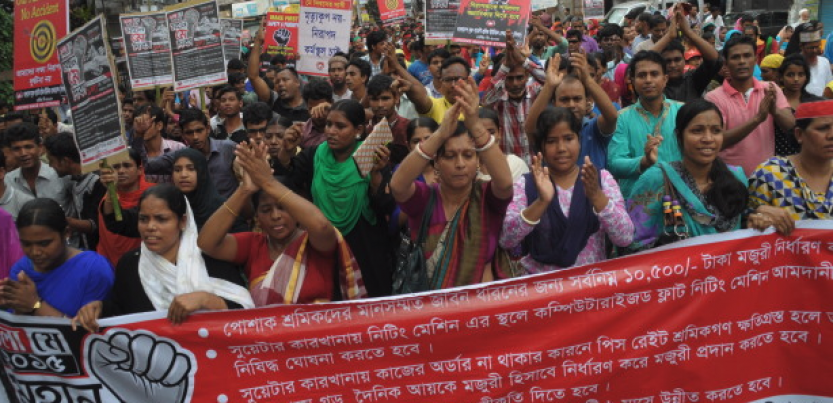Bangladesh Accord Gets a Lifeline While Workers Organize Wildcat Strikes

Image collected
On April 23, 2013, a local television crew shot footage of cracks in the Rana Plaza factory complex in Dhaka, Bangladesh. The building was evacuated, but the owner of the building declared it safe and told workers to come back the next day. One Walmart supplier housed in the building, Ether Tex, threatened to withhold a month’s wages from any workers who didn’t return.
The building collapsed on April 24, and when the rubble was finally cleared, 1,134 people were found dead, with another 2,500 injured. It was the worst industrial disaster in the history of the garment industry.
From the ashes of Rana Plaza emerged the Bangladesh Accord on Fire and Building Safety. An international compact among nonprofit organizations, Western manufacturers and retailers, local Bangladeshi union federations, and several major global unions, the Accord has monitored fire and building safety in 1,700 factories in Bangladesh over the past six years for signatory brands.
Among the main provisions of the Accord were independent monitoring of factories involving workers and unions, elected health and safety committees in workplaces, a worker complaint mechanism, the right to refuse dangerous work, and public disclosure of factory names, inspections data, and remediation plans.
Prior to the Rana Plaza collapse, garment factories themselves were largely responsible for policing factory conditions with toothless international monitoring schemes providing public relations cover for Western brands.
“Rana Plaza showed the world that self-regulated safety audits in Bangladesh were a farce,” said Léonie Guguen of global manufacturing union federation IndustriALL. “It was time for something radically different, and something which had muscle.”
The Accord differed from pure whitewash alternatives in that it was legally binding and required brands to maintain their relationships with suppliers while fixes to factories were being made. In other words, Western brands could no longer cut and run at the first sign of trouble or to blame safety conditions purely on local players rather than ponying up for repairs.
RESULTS
The Accord’s results have been impressive in terms of workplace safety. It has conducted 30,000 inspections and remedied more than 90 percent of violations at 1,000 factories. The fixes affect 2.5 million workers though some of the costliest improvements remain to be done, according to the International Labor Rights Forum (ILRF), a witness signatory to the Accord.
The Accord brought credibility—and, importantly, the dollars provided by international brands facing a PR disaster—to improving safety conditions in Bangladesh’s garment factories.
Eight Bangladeshi unions were brought to the table, as were IndustriALL and another global union federation, UNI. Crucially, dozens of international brands—mostly European—signed on.
“The Accord has been valuable in that it’s helped to open up some space for workers to organize,” said Monika Hartsel of the Solidarity Center. “It gives them a little cover knowing that the brands that source from the factories they’re organizing may be more responsive.”
Proponents of the Accord point in particular to its worker-complaint mechanism as a way of providing workers a voice. For example, a May 2019 report by the ILRF highlighted a 2017 situation at Ananta Apparels, which had structural damage to the building that led workers to fear an imminent collapse like Rana Plaza. Supervisors, factory ownership, and the BGMEA all cajoled and coerced workers to come back to work, but the workers filed an independent complaint with the Accord with the assistance of the National Garment Workers Federation. The factory was shut down and repaired, and the workers were restored four days pay for work missed.
Source: https://labornotes.org
Tags :
Previous Story
- Hard to start business here
- 6 Years After Rana Plaza Collapse, an Accord...
- Bangladesh: the Government challenges the Accord
- As international factory safety group ordered to leave...
- Bangladesh PM Wins 3rd Term After Violent Election,...
- After Rana Plaza: the politics of sharing
- The international project to fix Bangladesh’s garment industry...
- How can the private sector position Bangladesh for...